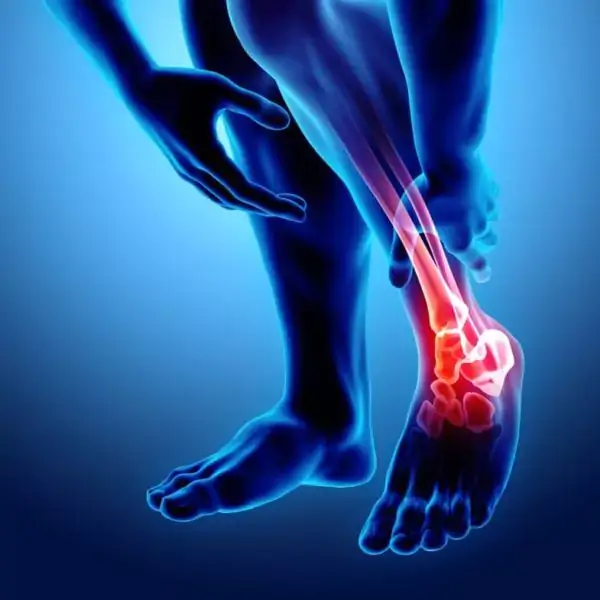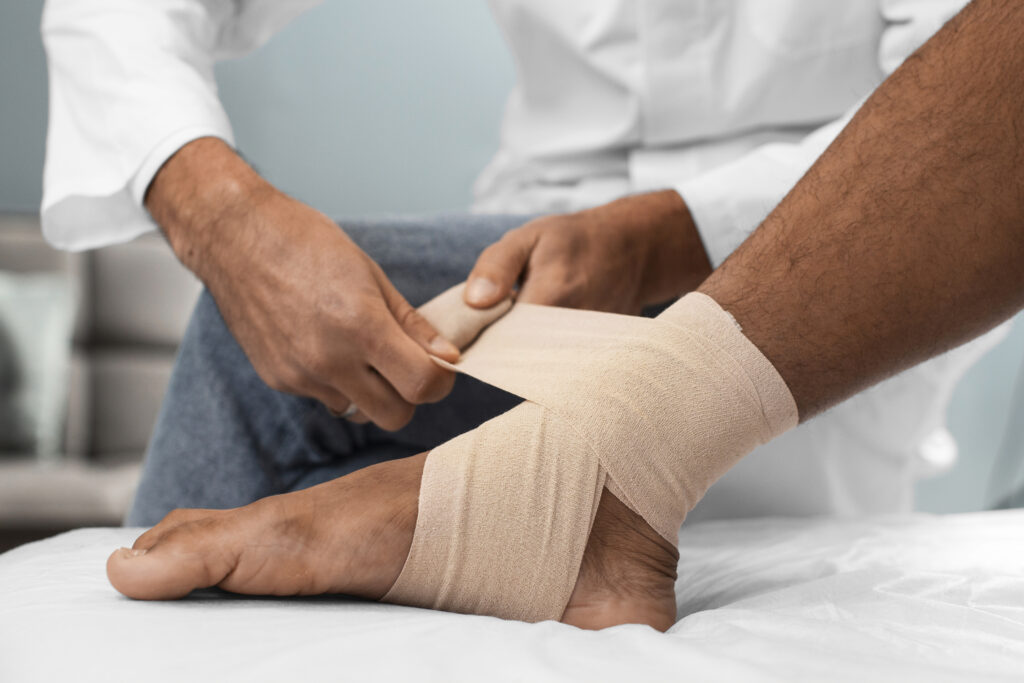FOOT AND ANKLE
FOOT AND ANKLE SPECIALIST IN CHANDIGARH- DR. VIKAS MEHRA
About Foot and Ankle Specialist in Chandigarh - Dr. Vikas Mehra
Dr. Vikas Mehra is a leading foot and ankle specialist in Chandigarh, known for his expertise in treating a wide range of foot and ankle conditions. From sports injuries to chronic pain and fractures, he provides advanced treatments to help patients regain mobility and comfort. His patient-friendly approach and modern techniques ensure effective and long-lasting results. Whether you need treatment for sprains, arthritis, or any other foot and ankle issue, Dr. Vikas Mehra is here to provide the best care and support for a healthier, pain-free life.

Why You Need a Foot and Ankle Specialist ?
Our feet and ankles play a vital role in everyday life. They support the entire weight of the body while helping us stand, walk, run, and move. When problems arise in this area, they can severely affect our ability to perform day-to-day activities. Foot and ankle issues can arise due to various factors, such as injury, aging, genetics, overuse, or medical conditions. Whether it’s a sudden injury or a chronic condition that develops over time, it’s essential to seek professional help from a foot and ankle specialist who can provide the right treatment.
Dr. Vikas Mehra, as a foot and ankle specialist in Chandigarh, has treated numerous patients for both acute injuries and long-standing conditions. His personalized approach ensures that every patient receives the most appropriate care for their individual needs. Whether you need conservative treatment options or are considering surgery, Dr. Mehra offers a broad spectrum of treatment options to help you heal and regain mobility.

Conditions Treated by Dr. Vikas Mehra - Foot & Ankle Specialist in Chandigarh
Dr. Mehra is a skilled specialist who treats a wide variety of foot and ankle problems. Some of the most common conditions he treats include:
1. Sports Injuries
Sports-related foot and ankle injuries are incredibly common, especially among athletes and active individuals. These injuries often include sprains, strains, fractures, and tendon injuries. Ankle sprains, in particular, are a frequent issue, and if left untreated, they can lead to long-term instability and weakness.
Dr. Mehra uses a comprehensive approach to treat sports injuries, combining rest, physical therapy, and in some cases, minimally invasive surgery. His goal is always to help patients recover quickly and safely, enabling them to return to their active routines with full functionality.
2. Arthritis
Arthritis is a condition that affects the joints, causing pain, swelling, stiffness, and reduced mobility. The two most common types of arthritis that affect the foot and ankle are osteoarthritis and rheumatoid arthritis. Osteoarthritis occurs when the cartilage in the joints wears down over time, while rheumatoid arthritis is an autoimmune disorder that causes inflammation in the joints.
Dr. Mehra helps manage arthritis with both non-surgical and surgical treatment options, depending on the severity of the condition. For early-stage arthritis, he may recommend physical therapy, medication, and custom orthotics to reduce pain and improve mobility. In advanced cases, surgery may be necessary to repair or replace damaged joints.
3. Bunions and Hammertoes
Bunions and hammertoes are common foot deformities that cause discomfort and affect the appearance of the feet. Bunions are bony bumps that form at the base of the big toe, while hammertoes occur when the toes curl unnaturally. Both conditions can make walking painful and difficult.
Dr. Mehra provides comprehensive treatment for bunions and hammertoes, including non-invasive options such as orthotics and splints. If these conservative treatments are not effective, surgery may be recommended to correct the deformities and relieve pain.
4. Plantar Fasciitis
Plantar fasciitis is one of the most common causes of heel pain. It occurs when the plantar fascia, a band of tissue that connects the heel bone to the toes, becomes inflamed. This condition can make it difficult to walk or stand for long periods of time, causing significant discomfort.
Dr. Mehra offers several treatment options for plantar fasciitis, including rest, physical therapy, stretching exercises, and custom orthotics. In more severe cases, he may recommend corticosteroid injections or minimally invasive surgical procedures to address the problem.
5. Flat Feet and High Arches
Both flat feet (fallen arches) and high arches are conditions that affect the alignment of the feet and can lead to various problems such as pain, instability, and difficulty walking. Flat feet occur when the arches of the feet collapse, while high arches place extra pressure on the foot’s heel and ball. Both conditions can result in discomfort and difficulty performing daily tasks.
Dr. Mehra offers customized treatment plans for individuals with flat feet or high arches, including the use of orthotics, physical therapy, and lifestyle modifications. For more severe cases, surgical correction may be necessary to restore normal foot function.
6. Ankle Instability
Chronic ankle instability is a condition that often results from repeated ankle sprains. It occurs when the ligaments in the ankle become stretched or torn, leading to weakness and instability. This can make the ankle prone to further injury and may hinder an individual’s ability to walk or engage in physical activities.
Dr. Mehra offers effective treatments for ankle instability, including rehabilitation exercises, physical therapy, and ankle bracing. In some cases, surgical intervention may be required to repair damaged ligaments and restore stability to the ankle.
Causes of Foot and Ankle Fractures
Foot and ankle fractures can occur due to several factors, including:
- Trauma or Injury: Falls, twists, or direct impacts during activities like sports can cause fractures.
- Car Accidents: The force from a vehicle collision can lead to serious fractures.
- Overuse: Repetitive stress from activities like running or dancing can cause stress fractures.
- Osteoporosis: Weak bones from osteoporosis make fractures more likely, even from minor falls.
- High-Impact Sports: Intense physical activities like football and gymnastics increase fracture risk.
- Age: Aging bones become more brittle and prone to fractures.
- Health Conditions: Conditions like diabetes, arthritis, or neurological disorders may increase fall risks.
- Accidents at Home or Work: Simple accidents at home or in the workplace can lead to fractures.
- Improper Footwear: Ill-fitting or unsupportive shoes increase the chance of twisting an ankle.
- Genetics: A family history of bone fragility can raise the likelihood of fractures.
To reduce risk, wear proper footwear, avoid high-risk activities, and take care of your bone health.
Symptoms of Foot and Ankle Fractures
The symptoms of foot and ankle fractures may vary depending on the severity and location of the injury. Common signs include:
- Pain: Sharp, intense pain at the site of the fracture, which may worsen with movement or pressure.
- Swelling: Swelling around the injured area, which can make it difficult to move the foot or ankle.
- Bruising: Discoloration or bruising around the injury due to blood vessels being damaged.
- Deformity: Visible deformity or irregular shape of the foot or ankle, indicating the bone may be out of place.
- Inability to Walk: Difficulty or inability to bear weight or walk without pain.
- Tenderness: Sensitivity when touching the injured area, indicating the bone is fractured.
- Numbness or Tingling: In some cases, nerve damage may cause a tingling sensation or numbness in the foot or toes.
- Warmth: The injured area may feel warm to the touch due to inflammation.
If you experience any of these symptoms, it’s important to seek medical attention immediately for proper diagnosis and treatment.
Comprehensive Foot and Ankle Treatments
As a leading foot and ankle specialist in Chandigarh, Dr. Mehra provides a wide range of treatments to address various foot and ankle conditions. The treatment approach is individualized, ensuring that each patient receives the care they need to recover fully.
Non-Surgical Treatments
For many patients, non-surgical treatments can be effective in managing foot and ankle problems. Dr. Mehra frequently recommends conservative options such as:
- Physical Therapy: Specific exercises and stretches are designed to improve strength, flexibility, and mobility.
- Custom Orthotics: Custom-made shoe inserts can help correct foot imbalances, provide support, and alleviate pain.
- Medication: Over-the-counter or prescription medication may be used to manage pain and inflammation.
- Injections: Corticosteroid injections can help reduce inflammation and pain in joints, tendons, and ligaments.
Surgical Treatments
In cases where non-surgical treatments are insufficient, Dr. Mehra may recommend surgery to correct the underlying issue. Some of the surgical options include:
- Arthroscopy: A minimally invasive surgical procedure that uses a small camera to examine and repair damaged joints or tissues.
- Joint Replacement: In cases of severe arthritis, joint replacement surgery may be necessary to restore function.
- Tendon Repair: Surgical repair of torn or damaged tendons to restore strength and function to the affected area.
Why Choose Dr. Vikas Mehra?
Choosing the right foot and ankle specialist is crucial for effective treatment and recovery. Here are some reasons why Dr. Vikas Mehra is a trusted foot and ankle specialist in Chandigarh:
- Expertise and Experience: Dr. Mehra has years of experience treating a wide range of foot and ankle conditions, providing expert care to patients of all ages.
- Personalized Treatment: He offers individualized care, ensuring that each patient receives the most appropriate treatment for their specific condition.
- Comprehensive Approach: Dr. Mehra provides both non-surgical and surgical options to ensure the best possible outcomes for his patients.
- State-of-the-Art Facilities: Dr. Mehra’s clinic is equipped with the latest technology for accurate diagnosis and effective treatment.
- Compassionate Care: Dr. Mehra and his team prioritize patient comfort, providing a supportive and caring environment for all patients.
FOOT AND ANKLE FRACTURE SURGERY RECOVERY
Recovering from foot and ankle fracture surgery requires patience and proper care. Initially, rest and immobilization are crucial to allow the bones to heal correctly. Pain management, including prescribed medications and ice therapy, helps reduce discomfort and swelling. As healing progresses, physical therapy plays a key role in restoring strength, flexibility, and mobility. Regular follow-up appointments ensure that recovery is on track and help detect any complications early. Gradually, you can return to normal activities, but it’s essential to avoid high-impact movements until full recovery. With the right approach, you can regain full function and mobility. For expert guidance and treatment, contact us today!
